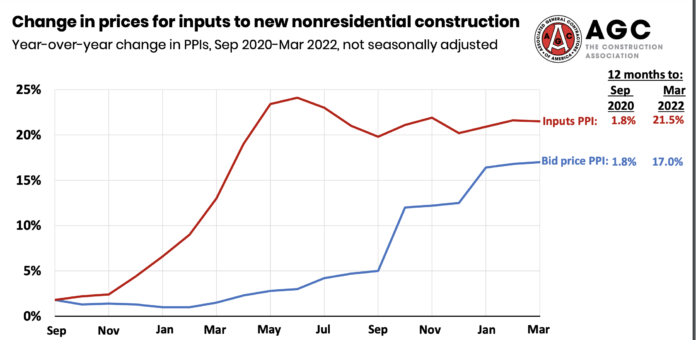Prices of materials and services used in new nonresidential construction jumped more than 21 percent from March 2021 to March 2022, according to an analysis by the Associated General Contractors of America (AGC) of government data released on April 13. The association urged the Biden administration to relieve major cost pressures by removing the remaining tariffs on aluminum, steel, and Canadian lumber.
“Construction firms have been burdened with cost increases of 20 percent per year or more since early 2021,” said Ken Simonson, the association’s chief economist. “Since contractors can seldom pass along increases on projects that are underway, these extreme price hikes threaten the viability of many firms. Unfortunately, the continuing war in Ukraine is likely to keep input costs elevated for many more months, if not longer.”
The producer price index for inputs to new nonresidential construction—the prices charged by goods producers and service providers such as distributors and transportation firms—rose 2.7 percent from February to March and 21.5 percent over the past 12 months. In comparison, the index for new nonresidential building construction—a measure of what contractors say they would charge to erect five types of nonresidential buildings—rose 0.6 percent for the month and 17.0 percent from a year earlier. March was the 18th-straight month in which the cost index rose more than the bid-price index on a year-over-year basis, Simonson noted.
Prices rose faster than the 17 percent increase in bid prices for a wide range of inputs in the cost index. The price index for diesel fuel leaped 63.8 percent over 12 months. The index for aluminum mill shapes jumped 43.7 percent. The index for steel mill products climbed 42.9 percent. The index for plastic construction products rose 35.2 percent over 12 months.
In addition, year-over-year increases exceeded 17 percent for the indexes covering truck transportation of freight, which climbed 24.5 percent; asphalt and tar roofing and siding products, 22.6 percent; lumber and plywood, 20.9 percent; gypsum products, 20.8 percent; architectural coatings, 20.6 percent; and insulation materials, 17.4 percent.
Association officials said tariffs as high as 25 percent on steel, 18 percent on Canadian lumber, and 10 percent on aluminum have worsened the extreme price increases for these inputs. They urged the Biden administration to remove the tariffs immediately to provide relief for employers grappling with rapidly rising materials costs.
“Given the impact inflation is already having on the economy, it makes no sense for the administration to continue to needlessly inflate the cost of key construction materials,” said Stephen E. Sandherr, the association’s chief executive officer. “Removing these tariffs will take some of the price pressure off of employers grappling to control costs.”







